 W
WAnomopoda is a suborder of the order Cladocera. These crustaceans, a type of water flea, are members of the Class Branchiopoda. The Anomopoda typically have five pairs of thoracic limbs, but sometimes have six pairs. The head of the Anomopoda lacks a clear separation from the trunk and the posterior, while the abdomen area gradually merges with the anterior of the trunk.
 W
WArchaebranchinecta barstowensis is a species of fairy shrimp (Anostraca) that inhabited California during the Middle Miocene. Its fecal material is abundant in the concretions from the Barstow Formation. A limited number of whole specimens have been found, and they represent the "best-preserved fossil anostracan known to date". The closest relative of A. barstowensis appears to be Archaebranchinecta pollicifera from the surroundings of Lake Titicaca, and the two have been separated from the genus Branchinecta as the new genus Archaebranchinecta.
 W
WArtemia monica, the Mono Lake brine shrimp, is a species of brine shrimp, endemic to Mono Lake in California, United States.
 W
WBosmina is a genus in the order Cladocera, the water fleas. Its members can be distinguished from those of Bosminopsis by the separation of the antennae; in Bosminopsis, the antennae are fused at their bases.
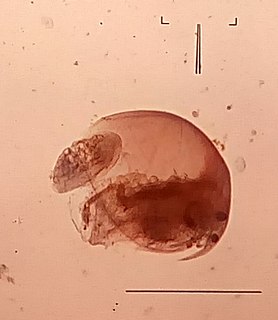 W
WBosminidae is a family of anomopods in the order Diplostraca. There are at least 3 genera and 40 described species in Bosminidae.
 W
WBranchinecta is a genus of crustacean in family Branchinectidae. It includes around 50 species, found on all continents except Africa and Australia. Branchinecta gigas, the giant fairy shrimp, is the largest species in the order, with a length of up to 10 centimetres (4 in), and Branchinecta brushi lives at the highest altitude of any crustacean, at 5,930 metres (19,460 ft), a record it shares with the copepod Boeckella palustris. A new genus, Archaebranchinecta was established in 2011 for two species previously placed in Branchinecta.Branchinecta achalensis Cesar, 1985 Branchinecta belki Maeda-Martínez, Obregón-Barboza & Dumont, 1992 Branchinecta brushi Hegna & Lazo-Wasem, 2010 Branchinecta campestris Lynch, 1960 – pocket-pouch fairy shrimp Branchinecta coloradensis Packard, 1874 – Colorado fairy shrimp Branchinecta constricta Rogers, 2006 Branchinecta conservatio Eng, Belk & Eriksen, 1990 – conservancy fairy shrimp Branchinecta cornigera Lynch, 1958 – horned fairy shrimp Branchinecta dissimilis Lynch, 1972 – Great Basin fairy shrimp Branchinecta ferox (M. Milne-Edwards, 1840) Branchinecta gaini Daday, 1910 Branchinecta gigas Lynch, 1937 – giant fairy shrimp Branchinecta granulosa Daday, 1902 Branchinecta hiberna Rogers & Fugate, 2001 – winter fairy shrimp Branchinecta iheringi Lilljeborg, 1889 Branchinecta kaibabensis Belk & Fugate, 2000 – Kaibab fairy shrimp Branchinecta lateralis Rogers, 2006 Branchinecta leonensis Cesar, 1985 Branchinecta lindahli Packard, 1883 – versatile fairy shrimp Branchinecta longiantenna Eng, Belk & Eriksen, 1990 – longhorn fairy shrimp Branchinecta lynchi Eng, Belk & Eriksen, 1990 – vernal pool fairy shrimp Branchinecta mackini Dexter, 1956 – alkali fairy shrimp Branchinecta mediospina Rogers, Dasis & Murrow, 2011 Branchinecta mesovallensis Belk & Fugate, 2000 – mid-valley fairy shrimp Branchinecta mexicana Maeda-Martínez, Obregón-Barboza & Dumont, 1992 Branchinecta minuta Smirnov, 1948 Branchinecta oriena Belk & Rogers, 2002 Branchinecta orientalis G. O. Sars, 1901 Branchinecta oterosanvicentei Obregón-Barboza, et al., 2002 Branchinecta packardi Pearse, 1912 – Packard fairy shrimp Branchinecta paludosa (O. F. Müller, 1788) – circumpolar fairy shrimp Branchinecta palustris Birabén, 1946 Branchinecta papillosa Birabén, 1946 Branchinecta potassa Belk, 1979 – Nebraska fairy shrimp Branchinecta prima Cohen, 1983 Branchinecta raptor Rogers, Quinney, Weaver, and Olesen 2006 Branchinecta readingi Belk, 2000 – Reading fairy shrimp Branchinecta rocaensis Cohen, 1982 Branchinecta sandiegonensis Fugate, 1993 – San Diego fairy shrimp Branchinecta serrata Rogers, 2006 Branchinecta somuncurensis Cohen, 1983 Branchinecta tarensis Birabén, 1946 Branchinecta tolli (G. O. Sars, 1897) Branchinecta valchetana Cohen, 1981 Branchinecta vuriloche Cohen, 1985
 W
WBranchinectidae is a family in the order Anostraca, containing two genera – Branchinecta and Archaebranchinecta. The majority of the species are in the genus Branchinecta, with only Archaebranchinecta pollicifera and the fossil Archaebranchinecta barstowensis in the second genus.
 W
WBranchinella is a genus of crustaceans in the family Thamnocephalidae. This fairy shrimp genus is found across many parts of the world, but especially western Australia and southern Africa.
 W
WBranchipodidae is a family of fairy shrimp, one of eight in the order Anostraca. It contains 35 extant species in five extant genera:Branchipodopsis G. O. Sars, 1898 Branchipus Schaeffer, 1766 Metabranchipus Masi, 1925 Pumilibranchipus Hamer & Brendonck, 1995 Rhinobranchipus Brendonck, 1995
 W
WChenops is an extinct genus of notostracan which existed in the Yixian Formation, Inner Mongolia, and the Jehol fauna of China during the early Cretaceous period. The genus was erected by Thomas A. Hegna and Ren Dong in 2010 to describe the Yixian species, Chenops yixianensis. A second species, originally described as "Prolepidurus oblongus", from the Jehol fauna, was redescribed as C. oblongus.
 W
WChirocephalidae is a family of fairy shrimp, characterised by a reduced or vestigial maxilla, more than two setae on the fifth endite, divided pre-epipodites and widely separated seminal vesicles. It consists of the following eight genera, including the genera formerly placed in the families Linderiellidae and Polyartemiidae:Artemiopsis G. O. Sars, 1897 Branchinectella Daday de Dées, 1910 Chirocephalus Prévost, 1820 Dexteria Brtek, 1965 Eubranchipus Verrill, 1870 Linderiella Brtek, 1964 Polyartemia Fischer, 1851 Polyartemiella Daday de Dées, 1909
 W
WChirocephalus is a genus of fairy shrimp in the family Chirocephalidae. It contains the following species:
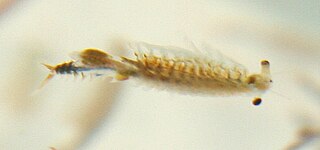 W
WChirocephalus croaticus is a species of fairy shrimp in the family Chirocephalidae. It is found only in Croatia and Slovenia and is listed as a vulnerable species on the IUCN Red List.
 W
WCyzicidae is a family of crustaceans in the order Spinicaudata. They are distinguished from the family Leptestheriidae by the absence of a rostral spine. Some members of Cyzicidae are known to burrow through mud, leading to speculation that they may be filter feeders, but Martin reports that their mouthparts are indistinguishable from Leptestheriidae, which are believed to be grazers.
 W
WCyzicus is a genus of clam shrimps in the family Cyzicidae. Identified by Jean Victoire Audouin in 1837, the genus was reidentified as Caenestheriella by Eugen von Daday in 1910.
 W
WDaphnia is one of the three subgenera of the genus Daphnia, the others being Australodaphnia and Ctenodaphnia.
 W
WDaphnia barbata is a species of water flea within the family Daphniidae. It occurs in several places within Africa including Lake Chad in northwest Africa and in the Makgadikgadi Pan in Botswana.
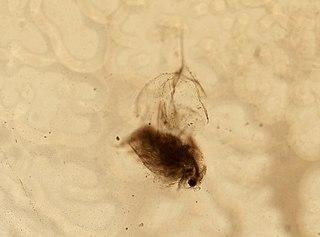 W
WDaphnia galeata is a small species of planktonic crustaceans. It lives in freshwater environments across a large area of the Northern Hemisphere, mostly in lakes.
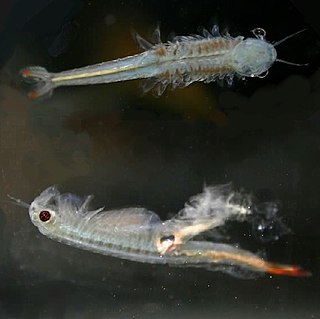 W
WDendrocephalus is a genus of fairy shrimp found in South and North America. It is characterised by the presence of an antenna-like appendage arising between the second antennae and the eyestalks. The genus comprises 16 species in two subgenera:Dendrocephalus Daday, 1908Dendrocephalus affinis Pereira, 1984 – Venezuela Dendrocephalus argentinus Pereira & Belk, 1987 – Paraguay Dendrocephalus brasiliensis Pesta, 1921 – Argentina, Brazil Dendrocephalus cervicornis (Weltner, 1890) – Argentina Dendrocephalus conosurius Pereira & Ruiz, 1995 Dendrocephalus cornutus Pereira & Belk, 1987 – Costa Rica Dendrocephalus geayi Daday, 1908 – Venezuela Dendrocephalus goiasensis Rabet & Thiéry, 1996 – Brazil Dendrocephalus orientalis Rabet & Thiéry, 1996 – Brazil Dendrocephalus sarmentosus Pereira & Belk, 1987 – Galápagos Islands Dendrocephalus spartaenovae Margalef, 1967 – Venezuela Dendrocephalus thieryi Rabet, 2006 – Brazil Dendrocephalus venezolanus Pereira, 1984 – VenezuelaDendrocephalinus Rogers, 2006Dendrocephalus acacioidea (Belk & Sissom, 1992) – United States Dendrocephalus alachua (Dexter, 1953) – United States Dendrocephalus lithaca Creaser, 1940 – United States
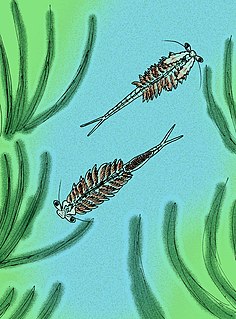 W
WDexteria floridana is an extinct species of fairy shrimp in the family Chirocephalidae, the only species in the genus Dexteria. It was endemic to Florida, where it was known from a single pool, south of Gainesville. It was originally described by Ralph W. Dexter in 1953 as a species of Eubranchipus. The species was declared extinct on October 5, 2011 because it was found that the only known pool of water that contained the known population was filled in for development, thereby killing the shrimps.
 W
WEubranchipus is a genus of brine shrimp and fairy shrimp in the family Chirocephalidae. There are about 16 described species in Eubranchipus.
 W
WEvadne is a genus of onychopods in the family Podonidae. There are at least four described species in Evadne.
 W
WHolopedium is the sole genus of water fleas in the family Holopediidae. There are about seven described species in Holopedium.
 W
WHolopedium gibberum is a species of ctenopod in the family Holopediidae. It is found in Europe.
 W
WIliella spinosa is an extinct species of kazacharthran branchiopod crustaceans from the Lower Jurassic of Kazakhstan. It had a unique carapace that was shaped like a spiny double-oval.
 W
WJeholops is an extinct genus of notostracan which existed in the Yixian Formation, inner Mongolia, China during the early Cretaceous period. It was described by Thomas A. Hegna and Ren Dong in 2010, and the only species is Jeholops hongi.
 W
WLepidurus is a genus of small crustaceans in the order Notostraca. It is the larger of the two extant genera of the tadpole shrimps, the other being Triops. They are commonly found in vernal pools and survive dry periods with the help of long lasting resting eggs.
 W
WLepidurus arcticus is a species of tadpole shrimp which inhabits both ephemeral pools and permanent freshwater lakes of Norway, Greenland, Finland, Sweden, Svalbard, Iceland, Russia and the Kuril Islands.
 W
WLimnadiidae is a family of crustaceans in the order Spinicaudata that live in seasonal wetlands, inland saline pools and lakes. They are found on all the world's continents except Antarctica, and are distinguished from other families in the same order by the fact that the cephalic fornicies do not extend forwards. The family contains eight extant genera:Afrolimnadia Rogers et al., 2012 Calalimnadia Rabet & Rogers, 2012 Eulimnadia Packard, 1874 Imnadia Hertzog, 1935 Limnadia Brongniart, 1820 Limnadopsis Spencer & Hall, 1896 Metalimnadia Mattox, 1952 Paralimnadia Sars, 1896
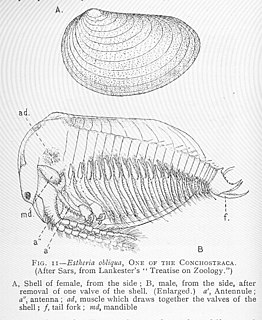 W
WLioestheria are an extinct genus of crustaceans that thrived from the Carboniferous to the Cretaceous. They fed on detritus, being very small slow moving, nektonic organisms that filter fed as they floated. They have been found in both marine and freshwater environments.
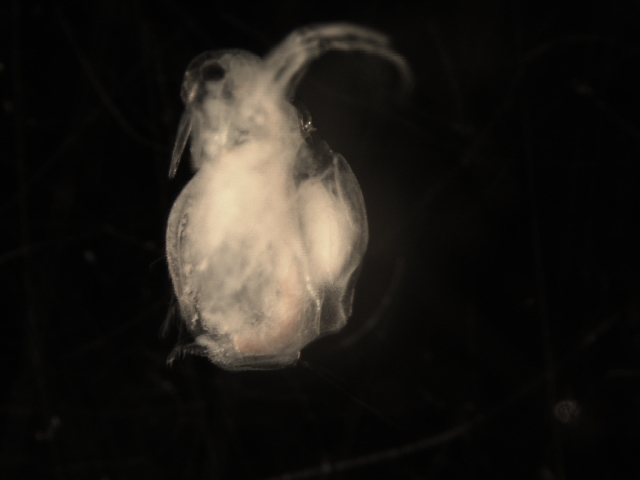 W
WMoina is a genus of crustaceans within the family Moinidae. The genus was first described by W. Baird in 1850. They are referred to as water fleas but are smaller than their more well-known cousins: the larger Daphnia magna and the medium-sized Daphnia pulex. This genus demonstrates the ability to survive in waters containing low oxygen levels as well as high salinity and other impurities, including salt pans, and commonly eutrophication. An example of such an extreme habitat is the highly saline Makgadikgadi Pans of Botswana, which supports the species Moina belli prolifically.
 W
WParartemia is a genus of fairy shrimp endemic to Australia. One species, P. contracta is listed as vulnerable on the IUCN Red List. Parartemia contains the following species:
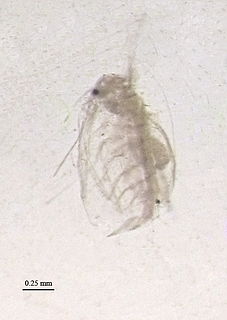 W
WPenilia is a genus of ctenopods in the family Sididae. There is one described species in Penilia, P. avirostris.
 W
WPenilia avirostris is a species of ctenopod in the family Sididae. It is found in temperate Asia, Europe, and New Zealand.
 W
WPodon is a genus of onychopods in the family Podonidae. There are at least four described species in Podon.
 W
WPodon leuckartii is a species of onychopod in the family Podonidae.
 W
WPodonidae is a family of onychopods in the order Diplostraca. There are about 8 genera and at least 20 described species in Podonidae.
 W
WPolyphemus pediculus is a species of onychopod in the family Polyphemidae. It is found in Europe.
 W
WProtocaris marshi is an extinct Cambrian arthropod that superficially resembles branchiopod notostracan crustaceans of the genus Triops.
 W
WSida is a genus of ctenopods in the family Sididae. There are about five described species in Sida.
 W
WSida crystallina is a species of ctenopod in the family Sididae. It is found in Europe.
 W
WSididae is a family of ctenopods in the order Diplostraca. There are about 6 genera and at least 20 described species in Sididae.
 W
WStreptocephalus is a genus of fairy shrimp found in temporary waters in Africa, Australia, Eurasia, and Central and North America, following its ancient origin in Gondwana. It contains the following species:
 W
WStreptocephalus woottoni, with the common name Riverside fairy shrimp, is a rare species of crustacean in the family Streptocephalidae. It is native to Southern California in the United States, and northern Baja California in northwest Mexico.
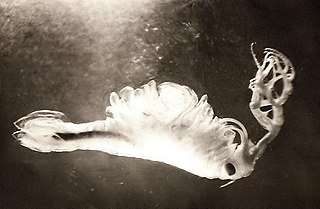 W
WThamnocephalidae is a family of crustaceans with wide distribution including Western Australia and Southern Africa. It was originally described as a subfamily of Branchipodidae by Alpheus Spring Packard in 1883, and elevated to the rank of family by Simon in 1886. Six genera are recognised, in two subfamilies:ThamnocephalinaeThamnocephalus Packard, 1879 Carinophallus Rogers, 2006BranchinellinaeDendrocephalus Daday, 1908 Phallocryptus Birabén, 1951 Spiralifrons Dixon, 2010 Branchinella Sayce, 1903
 W
WTriops granarius is a species of tadpole shrimp with a broad distribution from Africa and the Middle East to China and Japan, although there are indications that it, as presently defined, is a species complex. They have elongated bodies and large flaps. Triops granarius can be kept as pets in home aquaria. Their life expectancy is up to 90 days, and in that time they can grow more than 6 cm in length.
 W
WTriops newberryi is a species of Triops found on the western coast of North America, commonly in valleys throughout the states of Washington, Oregon, California, and small areas of Nevada, Utah, New Mexico, and Mexico, with at least one disjunct population in Kansas. They are found in vast numbers though in the Coachella Valley in California. T. newberryi has been reported to have potential as a biocontrol agent for larval mosquitoes breeding in seasonally-flooded habitats. T. newberryi is genetically distinct from T. longicaudatus, the dominant species in the Central United States.